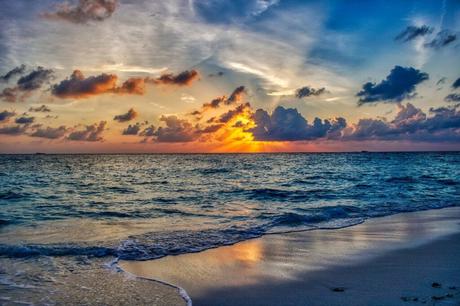
The Maldives is a dream destination for the discerning traveler, with Glamorous overwater resorts, pristine white-sand beaches, and an amazing undersea world. The sovereign archipelagic nation - located in the Indian Ocean southwest of India - comprises of 26 beautiful atolls that preserve ancient cultural traditions and natural wonders. All 1192 coral islands (200 inhabited islands plus 100 tourist resorts) are visible coral tips on the tip of an oceanic volcanic mountain range whose outer edge drops to depths of more than 3 km (10,000 ft).The tiny islands are surrounded by stunning beaches and lagoons with beautiful crystal-clear water, which are protected by coral reefs. Every resort in the Maldives is located on a palm island that is completely unique, with all of the world's most exclusive hotel brands competing for attention to give their guests breathtaking levels of luxury.If you're traveling to Sri Lanka, the Maldives is a great place to visit; both islands are just a short flight away. Flights between Sri Lanka and the Maldives are numerous (with a flying time of approximately one hour), making it easy to combine a holiday in the Maldives with a stay in Sri Lanka.
The Maldives is a tropical island nation, with almost all of the year's sunshine and temperatures that range from 60 to 86 degrees Fahrenheit (15 to 30 degrees Celsius). The islands are affected by two monsoons, which come from opposite directions and cause the trade winds to blow.
- The best weather in the Maldives is between January and mid-April, during the dry northeast monsoon. Although there will be some rain (especially in the southern atolls), you can expect clear blue skies and low humidity. The dry season also corresponds to the northern hemisphere's cold winter season, which makes this a popular time in the Maldives with low availability (although it never gets crowded) and frequently exorbitantly high room rates at resorts.
- The wet southwest monsoon season lasts from May to October, reaching its peak in June. Although the weather is as warm as it is during the dry season, rainy days and thunderstorms are much more prevalent. There may be days when the sky is overcast, or a few days at a time when it is cloudy. Even so, there are often lengthy periods of brilliant sunshine, and because room rates are cheaper throughout this period, it's still a good time to visit.
- The dry northeast and wet southwest monsoons usually switch places at some point between late November and early December, followed by a period of unsettled weather and overcast, rainy days. These transition periods are frequently paired with an extended spell of unsettled weather and gloomy days.
It's worth noting that the tropical climate in the Maldives and the precise moments of transition have grown increasingly unpredictable in recent years, with the wet season becoming drier and the dry season getting longer. Furthermore, there are considerable variations in weather patterns among atolls due to their vast size (800 km / 500 miles across), which is a sovereign state located on Indian Ocean Rodhadheel Bank.The northern atolls, which are home to the most luxurious resorts in the archipelago, receive more sunshine and have less annual rain than the central atolls (where Male is located) and south-eastern islands. This climatic distinction is largely due to the length of the dry season being greater in the northmost atolls.
Not only are the beaches and resorts of the Maldives popular among tourists, but they are also a destination for world-class diving and the chance to swim with manta rays and whale sharks. Diving conditions are excellent all year, however areas frequented by larger marine animals vary with the seasons. During the dry northeast monsoon season, manta ray and whale shark diving in the Maldives is best on the western side of atolls, whereas during the Southeast Monsoon season, manta rays and whale sharks will generally be encountered near the eastern edge of atolls.
It's my opinion that it is worth paying more for a better experience and sticking to the dry season in the Maldives (January to mid-April) because there isn't much to do on a rainy day, other than drink, eat, exercise, or scuba dive.
HOW TO GET THERE
The majority of the Maldives' isolated resorts on distant private islands are reachable by boat or floatplane from Male International Airport (MLE; also known as Velana International Airport), which is in the North Male Atoll near Male. The airport is served by a variety of international Asian and European airlines, both charters and mainline carriers. For a list of airlines that fly directly to Male International Airport,
Visas for entering the Maldives vary from country to country and are occasionally updated. Always double-check with your government and a nearby Maldivian consulate or embassy before leaving to ensure you have all of the necessary paperwork.
- A passport is required. The passport should be valid for at least six months after arrival in the Maldives.
- The Maldives have a simple visa policy, with everyone entitled to a free 30-day visa on arrival if they have a valid travel document, an onward ticket, and proof of adequate funds.
SUGGESTED ITINERARIES
The majority of travelers to the Maldives stay at one resort for a week. I don't recommend traveling around too much in the Maldives since getting from one resort to another is time-consuming and expensive (since you usually have to return via Male airport).
However, if the prospect of spending a full week at one resort on a tiny island is too much for you, there are several resorts that may be easily linked in one trip because they are either located on the same atoll or connected by a direct and private (and frequently costly) speedboat transfer. A few instances:
- On the western side of the country, off the coast of Noonu Atoll, you'll find Soneva Jani (Luxury Resort), Cheval Blanc Randheli (Resort), and Velaa Private Island.
- Jum also has an exclusive spa facility and a boutique hotel on Baa Atoll (a UNESCO Biosphere Reserve) in the Maldives. Soneva Fushi, Four Seasons Landaa Giravaaru, Anantara Kihavah
- The top resorts on the island include: One & Only Reethi Rah, Patina Maldives, The Ritz-Carlton Fari Islands, Four Seasons Kuda Huraa, and Gili Lankanfushi.
- Maldives: Male Atoll: Taj Exotica Resort & Spa, Waldorf Astoria Maldives Ithaafushi, Naladhu, and COMO Cocoa Island
In addition, a select number of ultra-deluxe hotel operators operate more than one resort in the Maldives and provide a higher level of service between them. A few examples are Travelodge (Taj Exotica) and Island Lagoon Resort & Spa, which offers transfers by speedboat or yacht to both resorts at the exclusive Double Tree by Hilton Ambagan Beach Resort and Spa on Velavaru island, as well as some private island locations.
- Soneva Fushi and Soneva Jani (60 minute speedboat transfer between the two resorts)
- Four seasons are a must-see in Landaa Giravaaru, including Four Seasons Landaa Giravaaru and Kuda Huraa (40-minute water taxi ride).
- COMO Hotels & Resorts: COMO Cocoa Island and COMO Maalifushi (watertaxi transfer time of 45 minutes)

